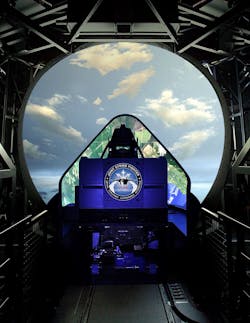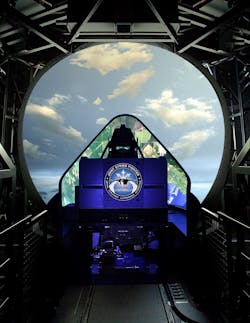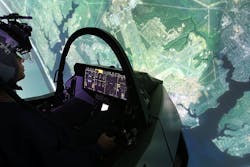Next-generation U.S. fighter aircraft pilot training deploys advanced simulation technology
By Michael Callahan, product marketing manager at RGB Spectrum
Simulation plays a prominent role in the F-35 Lightning II Joint Strike Fighter (JSF), the next-generation fighter aircraft that requires pilots to master new competencies, more so than legacy platforms. Given the F-35’s advanced capabilities, it is not possible to adequately challenge pilots in the live environment alone. The F-35 Full Mission Simulator (FMS) is, therefore, designed to train pilots for a broad experience range of air-to-air, air-to-ground, and electronic warfare missions and provide the most realistic experience possible.
The high-fidelity F-35 FMS involves the main aircraft systems, including avionics, integrated electronic sensors, target acquisition, weapons control, displays, and communications systems that collect and present data to the pilot and other friendly aircraft. Highly capable recording and transmission are required to support the Instructor’s Operating Station (IOS) and the debriefing room.
DGy codecs record, replay, and compress streaming for ideal visual feedback
Two of the core components in the FMS are the RGB Spectrum DGy JPEG 2000 recording and streaming codec and the Multicast Video Server (MVS) multi-channel storage and recording management system. DGy codecs are used in each of the FMS’s multiple pilot pods. The DGy codecs simultaneously stream and record all visuals and data the pilots observe during maneuvers, including avionics, navigation, out-the-window imagery, target acquisition, and weapons control.
The DGy codecs’ streams are transmitted to the IOS so instructors can view the actual visuals being seen by pilots during the live simulation exercise. Concurrently, these simulation visuals are recorded to the RGB Spectrum Multicast Video Server (MVS) for central storage and recording management. Following the live mission simulation exercises, DGy codecs are used in the After Action Review (AAR) debriefing facility with the mission crews to replay the simulation visuals and assess pilots' performance.
The DGy codec’s innovative JPEG 2000 compression produces visually lossless streaming and recording, preserving the most intricate detail. Another key advantage of DGy codec deployment in the FMS is the DGy codec’s ability to record every single frame. This unique capability is ideally suited ideal for frame-by-frame review during the AAR debriefing and post-simulation analysis by Instructors.
DGy codecs stream and record at up to 1920 x 1200-pixel resolution. The codecs offer an unparalleled feature set, including external time code synchronization (IRIG-B or Network Time Server), event marking, random access, variable speed playback, frame-by-frame jog/shuttle, and the exclusive recording failsafe feature which automatically protects recordings in a catastrophic system failure. Event marks can be inserted at key instances both during the recording process and in the post-simulation exercise debriefing replay. These event marks provide fast, convenient random access in the after- action-review to the desired marked points. The DGy codecs are integrated into the FMS using their API for control with other simulator components such as image generators, etc.
RGB Spectrum’s DGy codecs are the de facto standard for mission-critical applications, simulation, training, missile testing, and C4ISR. Other high-profile installations include: P-8 Poseidon trainers, simulators for the Global Hawk/Triton UAV, F-16 and F-22 aircraft, Apache, Kiowa, Chinook, and Blackhawk helicopters, and operational deployments on the U.S. Navy AEGIS destroyer fleet, the Canada Navy frigate fleet, and the THAAD and MEADS missile defense programs.
Key F-35 aircraft system components integrated into the mission simulation training
The F-35’s advanced sensor fusion enables pilots to assimilate and correlate information from all on-board sensors to create a single integrated picture of the battlefield. All the information gathered is then automatically shared with other strike aircraft pilots and platforms engaged in assigned missions.
The F-35’s Helmet Mounted Display Systems (HMDS) provide pilots with unprecedented situational awareness. All the information pilots need to complete their missions – airspeed, heading, altitude, targeting information and warnings – is projected on the helmet’s visor. The F-35’s Distributed Aperture System (DAS) is a 360-degree, spherical situational awareness system. The DAS streams real-time imagery to the helmet from six infrared cameras mounted around the aircraft allowing pilots to “look through” the airplane. Using this technology, pilots can see the entire environment surrounding them from any orientation, no matter which way the pilot is looking. Additionally, the DAS provides missile detection and tracking, situational awareness ISR, weapons support, navigation, fire control, and precision tracking of friendly aircraft for tactical maneuvering.
The F-35’s Active Electronically Scanned Array (AESA) radar enables pilots to effectively engage air and ground targets at long range.
The F-35’s Electro-Optical Targeting System (EOTS) is the first and only sensor that combines forward-looking infrared (FLIR) and infrared search and track (IRST) functionality. The system further enhances F-35 pilots’ situational awareness and provides precision air-to-air and air-to-surface targeting capabilities.
Training for the future
The F-35 aircraft is intended to provide the bulk of the manned tactical airpower of the U.S. Air Force, Navy, and Marine Corps over the coming decades. The JSF program was designed to replace the U.S. military’s F-16, A-10, F/A-18, and AV-8B fighter aircraft. The state-of-the-art F-35 aircraft is dramatically more effective than legacy fighters in air-to-air and air-to-ground combat, reconnaissance and suppression of enemy air defenses.
The F-35 Lightning II was conceived with participation from nine major partner nations: United States, United Kingdom, Italy, Netherlands, Canada, Turkey, Australia, Norway and Denmark. The nine partner nations plan to acquire over 3,100 F-35s through 2035.
Founded in 1987, RGB Spectrum provides innovative solutions for the display, recording, and distribution of audio and video content. RGB Spectrum's products are preferred by major, global organizations in corporate, security, medical, educational, government and defense/aerospace markets.
About the author
Michael Callahan is a Product Marketing Manager for RGB Spectrum, specializing in video wall processor, multiviewer, and codec product lines. Spanning his 37-year sales and marketing career, he has been involved with manufacturers in the inception of the PC market and the evolution of the audiovisual industry.
Search the Aerospace & Defense Buyer's Guide
The go-to resource for Intelligent Aerospace technology news & information:
Covering key topics
Across all market segments
Subscribe to the free Intelligent Inbox e-newsletter
Subscribe to receive all the latest aerospace technology news & information, delivered directly to your e-mail inbox twice a week (Tuesdays and Thursdays). Sign upfor your free subscription to the Intelligent Inbox e-newsletter at http://www.intelligent-aerospace.com/subscribe.html.
Connect on social media
Keep pace with aerospace innovation and opportunities via your favorite social media channels. Connect with Intelligent Aerospace on Twitter (@IntelligentAero), LinkedIn,Google+, and Instagram.




